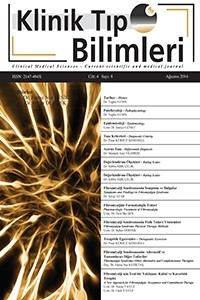Akut Gastrointestinal Kanamanın Bazı Sebepleri: Tespit, Lokalizasyon ve Konvansiyonel Tedavi Anjiyografi
kanama, akut, embolizasyon, kateterler, bt, anjiyoplasti, arterler, aorta
___
- 1. Jaeckle T, Stuber G, Hoffmann MHK, Freund W, Schmitz BL, Aschoff AJ. Acute gastrointestinal bleeding: Value of MDCT. Abdom Imaging 2008; 33:285-293.
- 2. Yoon W, Jeong YY, Kim JK. Acute gastrointestinal bleeding: contrastenhanced MDCT. Abdom Imaging 2006; 31:1-8.
- 3. Sanders DS, Perry MJ, Jones SGW, et al. Effectiveness of an uppergastrointestinal haemorrhage unit: a prospective analysis of 900 consecutive
- cases using the Rockall score as a method of risk standardization. Eur J Gastroenterol Hepatol 2004; 16:487-494
- 4. Van Leerdam ME, Vreeburg EM, Rauws EAJ, et al. Acute upper GI bleeding: did anything change? Time trend analysis of incidence and
- outcome of acute upper GI bleeding between 1993/1994 and 2000. Am J Gastroenterol 2003;98:1494-1499
- 5. Longstreth GF. Epidemiology and outcome of patients hospitalized with acute lower gastrointestinal hemorrhage: a population-based study. Am J Gastroenterol 1997;92:419-424
- 6. Anthony T, Penta P, Todd RD, et al. Rebleeding and survival after acute lower gastrointestinal bleeding. Am J Surg 2004;188:485-490
- 7. Stuber T, Hoffmann MHK, Stuber G, Klass O, Feuerlein S, Aschoff AJ. Pitfalls in detection of acute gastrointestinal bleeding with multi- detector row helical CT. Abdom Imaging 2009;34:476-482
- 8. Boley SJ, DiBiase A, Brandt LJ, Sammartano RJ. Lower intestinal bleeding in the elderly. Am J Surg 1979; 137:57.
- 9. Laing CJ, Tobias T, Rosenblum DI, Banker WL, Tseng L, Tamarkin SW. Acute Gastrointestinal Bleeding: Emerging Role of Multidetector
- CT Angiography and Review of Current Imaging Techniques. Radiographics 2007;27:1055-1070.
- 10. Uflacker R. Transcatheter embolization for treatment of acute lower intestinal bleeding. Acta Radiol 1987;28:425.
- 11. Slavin RE. Segmental arterial mediolysis: course, sequelae, prognosis, and pathologic-radiologic correlation. Cardiovascular Pathology 2009;18:352-360.
- 12. Chao CP. Seminars in Interventional Radiology. 2009;26:224-32.
- 13. Baker-LePain JC, Stone DH, Mattis A, Nakamura MC, Fye KH. Clinical Diagnosis of Segmental Arterial Mediolysis: Differentiation from
- Vasculitis and Other Mimics. Arthritis Care Res (Hoboken) 2010;62:1655-1660.
- 14. Habib N, Hassan S, Abdou R, Torbey E, Alkaied H, Maniatis T, Azab B, Chalhoub M, Harris K. Gastroduodenal artery aneurysm, diagnosis,
- clinical presentation and management: a concise review. Annals of Surgical Innovation and Research 2013;7:4
- 15. Iyori K, Horigome M, Yumoto S, Yamadera Y, Saigusa Y, Iida F, et al. Aneurysm of the gastroduodenal artery associated with absence of the celiac axis: report of a case. Surg Today 2004;34:360-362.
- 16. Shanley CJ, Shah NL, Messina LM. Uncommon splanchnic artery aneurysms: pancreaticoduodenal, gastroduodenal, superior mesenteric, inferior mesenteric, and colic. Ann Vasc Surg 1996;10:506-515.
- 17. Chong WW, Tan SG, Htoo MM. Endovascular treatment of gastroduodenal artery aneurysm. Asian Cardiovasc Thorac Ann 2008;16:68-72.
- ISSN: 2147-494X
- Başlangıç: 2013
- Yayıncı: Selen Medya Yayıncılık Tanıtım ve Organizasyon Hizmetleri
Dinçer ATİLA, Onur DALGIÇ, Yasemin KILIÇ, İstemihan TENGİZ
Eklem Dekstrüksiyonları Olan Son Evre Bir Gut Artriti Vakası
Acil Servis Hekimlerinin Bilgisayarlı Tomografi Tetkikine Yaklaşımlarının Değerlendirilmesi
Diyaliz Kateterine Bağl Triküspit Kapak Protrüzyonu ve Gelişen Çift Jet Akımlı Tiküspit Yetmezliği
Eren Ozan BAKIR, Nurullah ÇETİN, Bekir Serhat YILDIZ, Özgür BAYTURAN, Hakan TIKIZ
Elçin AYDIN, Fatih DÜZGÜN, Halil BOZKAYA, İsmail ORAN, Mustafa PARILDAR, Celal ÇINAR
Variköz Venler: Gebeliğin Hediyesi
Onur ÖZTÜRK, Metin OCAK, Gülşah ÖZTÜRK
Mediastinel Yağ İçeren Lezyonlar
Elçin AYDIN, Selen BAYRAKTAROĞLU, Cihan ALTIN, Naim CEYLAN, Recep SAVAŞ
Orkun KOBAN, Ahmet ÖĞRENCİ, Ezgi AYÇİÇEK, Turgay BİLGE, Mustafa ALİ AKÇETİN
